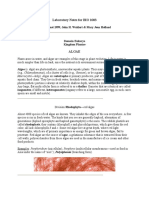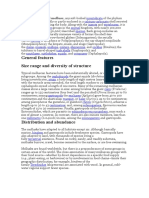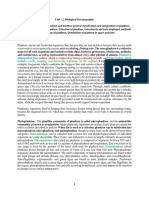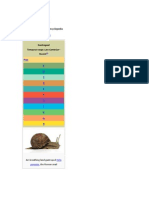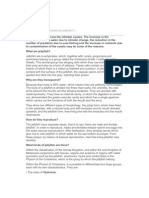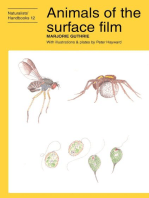Mon
Mon
Uploaded by
Mona Liza TanglaoCopyright:
Available Formats
Mon
Mon
Uploaded by
Mona Liza TanglaoOriginal Title
Copyright
Available Formats
Share this document
Did you find this document useful?
Is this content inappropriate?
Copyright:
Available Formats
Mon
Mon
Uploaded by
Mona Liza TanglaoCopyright:
Available Formats
Classification
Higher order taxa:
Eukaryota, stramenopiles
Classes:
Diatoms (Bacillariophyta), Golden-brown algae (Chrysophyceae), Yellow-green algae (Xanthophyceae)
Description and Significance
Chrysophyta is a phylum of unicellular marine or freshwater protists. Members of this phylum include the diatoms (class Bacillariophyta), golden/golden-brown algae (class Chrysophyceae), and yellow-green algae (class Xanthophyceae). Species' characteristics are varied: some are freeswimming unicells, while others are filamentous or colonial. Many chysophtyes are photosynthetic, which led to their initial categorization as plants. Actually, however, they are protist "secondary endosymbionts." That is, their evolutionary history included ingestion of an algae that already possessed a chloroplast descendent of a photosynthetic bacterium. The ingested algae (with its chloroplast) ultimately degenerated as an obligate organelle of the protist cell.
Genome Structure
Two Chrysophyta mitochondrial genomes have been sequenced (see them here).
Cell Structure and Metabolism
Diatoms Image from Texas Parks and Wildlife
Golden alga Image from Texas Parks and Wildlife. Because Chrysophyta encompasses so many species, there is no common cell structure. Some cell walls are comprised mainly of cellulose, with large amounts of silica, while some are amoeboid with no cell walls. If flagella are present, there may be one or two; if there are two they may or may not be similar. Diatoms are capable of reproducing sexually, but the chrysophytes commonly reproduce through cell division. Members of Chrysophyta tend to be photosynthetic, but some, especially the golden algae, become heterotrophic when there is inadequate light or if dissolved food is plentiful.
Ecology
Centric fossile diatom frustule. Image from Dennis Kunkel Microscopy at www.DennisKunkel.com. Members of Chrysophyta are found in marine and freshwater environments. The diatoms and the golden-brown algae are the most ecologically significant; they make up part of the plankton and nanoplankton that are the foundation of the aquatic food chain. Distribution of these organisms depend on the class to which they belong. .Chrysophyta - mostly freshwater eukaryotic algae having the chlorophyll masked by brown or yellow pigment; yellow-green and golden-brown algae and diatoms: Xanthophyceae, Chrysophyceae, Bacillariophyceae; some classification systems superseded or subsumed by Heterokontophyta division Chrysophyta kingdom Protoctista, Protoctista - in most modern classifications, replacement for the Protista; includes: Protozoa; Euglenophyta; Chlorophyta; Cryptophyta; Heterokontophyta; Rhodophyta;
unicellular protists and their descendant multicellular organisms: regarded as distinct from plants and animals golden algae - algae having the pigments chlorophyll and carotene and xanthophyll yellow-green algae - any alga of the division Chrysophyta with its chlorophyll masked by yellow pigment Chrysophyceae, class Chrysophyceae, class Heterokontae, Heterokontae - all the yellow-green algae having flagella of unequal length class Xanthophyceae, Xanthophyceae - yellow-green algae Bacillariophyceae, class Bacillariophyceae, class Diatomophyceae, Diatomophyceae - marine and freshwater eukaryotic algae: diatoms Heterotrichales, order Heterotrichales - yellow-green algae with simple or branching filaments; comprising the single family Tribonemaceae division - (biology) a group of organisms forming a subdivision of a larger category
Introduction to the Chrysophyta
Golden Algae
Chrysophytes, or golden algae, are common microscopic chromists in fresh water. Some species are colorless, but the vast majority are photosynthetic. As such, they are particularly important in lakes, where they may be the primary source of food for zooplankton. They are not considered truly autotrophic by some biologists because nearly all chrysophytes become facultatively heterotrophic in the absence of adequate light, or in the presence of plentiful dissolved food. When this occurs, the chrysoplast atrophies and the alga may turn predator, feeding on bacteria or diatoms.
There are more than a thousand described species of golden algae, most of them free-swimming and unicellular, but there are filamentous and colonial forms. Other chrysophytes may spend part of their life as amoeboid cells. At the left and center of the above illustration is Dinobryon, a freshwater genus in which the individual cells are surrounded by vase-shaped loricae, composed of chitin fibrils and other polysaccharides. The colonies grow as branched or unbranched chains. A spherical colonial form, Synura, is on the right; the surfaces of these cells are covered by silica scales. Species which produce siliceous coverings may have bristles or scales with quite complex structure. Some researchers group the chrysophytes with silica scales in a separate taxon, the Synurophyceae. The oldest known chrysophytes are from calcareous and siliceous deposits of Cretaceous age, but they reached their greatest diversity in the Miocene. The group actually has a fairly complete fossil record, because most freshwater chrysomonads secrete resting cysts of silica, which may be abundant in certain rocks -- in some Paleocene deposits, chrysophyte cysts outnumber the diatoms! The fossils of chrysophytes, like those of diatoms and coccolithophorids, are often used as paleoecological indicators to reconstruct ancient environments. It is now generally believed that the Chrysophyta is a heterogeneous group, probably paraphyletic. Several groups formerly included here have been given separate recognition, such as the Raphidiophyceae, Eumastigophyceae, Xanthophyceae, Silicoflagellata, Sarcinochrysophyceae, and others. However, there is as yet no general consensus as to how these groups are related to each other or to the other chromist groups.
You might also like
- Chrysophytes, or Golden Algae, Are Common Microscopic Chromists in FreshDocument3 pagesChrysophytes, or Golden Algae, Are Common Microscopic Chromists in Freshmulardi100% (1)
- AnswersDocument3 pagesAnswersRagel CoNo ratings yet
- Laboratory Notes For BIO 1003Document7 pagesLaboratory Notes For BIO 1003kedahn9No ratings yet
- 4-Classifications of AlgaeDocument24 pages4-Classifications of AlgaeLeslie Ann Ü Dag-umanNo ratings yet
- JurnalDocument4 pagesJurnalBunga Giftha NurhamsryNo ratings yet
- Introduction To Kingdom ProtistaDocument6 pagesIntroduction To Kingdom ProtistaJersson JuarioNo ratings yet
- Zooplankton: Jump To Navigation Jump To SearchDocument28 pagesZooplankton: Jump To Navigation Jump To SearchsakuraleeshaoranNo ratings yet
- SeaweedsDocument47 pagesSeaweedsJozel Margarette CruzNo ratings yet
- MolluskDocument4 pagesMolluskSoleil ValleNo ratings yet
- Corals Mediterranean EngDocument86 pagesCorals Mediterranean EngOlivia Panterka VainillaNo ratings yet
- Chapter 10Document5 pagesChapter 10Lebanan Aprille MarieNo ratings yet
- Monoplacophorans: Sea Slugs, Squid, Snails, and ScallopsDocument4 pagesMonoplacophorans: Sea Slugs, Squid, Snails, and ScallopsCoevicNo ratings yet
- Olutola Assignment MCBDocument7 pagesOlutola Assignment MCBOLUTOLA ADEMOLANo ratings yet
- Phylum Bryozoa: Organism: The Bryozoan Animal Is Called Zooid. Zooids Within A ColonyDocument5 pagesPhylum Bryozoa: Organism: The Bryozoan Animal Is Called Zooid. Zooids Within A ColonyDhaffer Al-MezhanyNo ratings yet
- The MolluscaDocument1 pageThe Molluscaedward.masseyNo ratings yet
- Description MicroscopeDocument4 pagesDescription MicroscopeRanma SaotomeNo ratings yet
- Lamprey: Lampreys (Sometimes Inaccurately Called Lamprey Eels) Are An Ancient, ExtantDocument15 pagesLamprey: Lampreys (Sometimes Inaccurately Called Lamprey Eels) Are An Ancient, ExtantHung Nguyen DoNo ratings yet
- Algal Origin and DiversityDocument18 pagesAlgal Origin and DiversityArunchand RayarothNo ratings yet
- Fish As Food Fish (Disambiguation) VertebrataDocument15 pagesFish As Food Fish (Disambiguation) VertebrataGemlyn de CastroNo ratings yet
- Phylum Mollusca: April 2018Document73 pagesPhylum Mollusca: April 2018Paul DoorelNo ratings yet
- Assignment 1Document5 pagesAssignment 1Zephaniah SomeraNo ratings yet
- 3A General - ClassificationDocument10 pages3A General - Classificationনাজমুল হক শাহিনNo ratings yet
- Classification by Depth Distribution of Phytoplankton and ZooplanktonDocument31 pagesClassification by Depth Distribution of Phytoplankton and ZooplanktonKeanu Denzel BolitoNo ratings yet
- Classification of ProtistsDocument46 pagesClassification of ProtistsrameenremNo ratings yet
- Group 4 1Document13 pagesGroup 4 1RAKIBUL HASANNo ratings yet
- Phylum ChordataDocument15 pagesPhylum Chordatay_khartashNo ratings yet
- Explain The Class BivalviaDocument6 pagesExplain The Class BivalviaRabiu sadiqNo ratings yet
- Plankton MSC Zoology Fourth SemesterDocument27 pagesPlankton MSC Zoology Fourth SemesterAnita DwivediNo ratings yet
- E1i021031 - Teungku Ario Naldo - English (Coloring Words)Document2 pagesE1i021031 - Teungku Ario Naldo - English (Coloring Words)Teungku Ario NaldoNo ratings yet
- Marine Biology-LecNote-Unit-2 PDFDocument9 pagesMarine Biology-LecNote-Unit-2 PDFYashNo ratings yet
- Kingdom Animalia - Ernesto MarinDocument26 pagesKingdom Animalia - Ernesto MarinsanazhNo ratings yet
- Types of Marine OrganismsDocument10 pagesTypes of Marine OrganismsHira AnwarNo ratings yet
- Protists: A Study Guide (Biology)Document2 pagesProtists: A Study Guide (Biology)Thomas Trotter100% (1)
- Marine ReportDocument19 pagesMarine ReportEdjey Luis F. MatinongNo ratings yet
- DINOFLAGELATADocument41 pagesDINOFLAGELATAgraciaNo ratings yet
- Group 5 - Algae and BryophyesDocument32 pagesGroup 5 - Algae and Bryophyesalayanjoshua26No ratings yet
- Biology of Algae Lec 6Document16 pagesBiology of Algae Lec 6farhanbinhabibNo ratings yet
- Algae: Reported by Group 5Document36 pagesAlgae: Reported by Group 5Angelina RossNo ratings yet
- Intro CnidariaDocument2 pagesIntro Cnidariaapi-303098361No ratings yet
- Chapter 4Document172 pagesChapter 4Aan AkmalNo ratings yet
- Plankton Ex 4Document28 pagesPlankton Ex 4Brilliant Jay Lagria100% (1)
- General Characters of AlgaeDocument50 pagesGeneral Characters of AlgaeAnilNo ratings yet
- Origin and EvolutionDocument5 pagesOrigin and Evolutionsmritiyay90No ratings yet
- Chapter 2 Literature ReviewDocument30 pagesChapter 2 Literature ReviewSemana HumedalesNo ratings yet
- ALGAE LectureDocument10 pagesALGAE Lecturesung_kei_pinNo ratings yet
- Gastropoda: From Wikipedia, The Free Encyclopedia Jump ToDocument9 pagesGastropoda: From Wikipedia, The Free Encyclopedia Jump ToDianita Saraita VGNo ratings yet
- Radiate AnimalsDocument58 pagesRadiate AnimalsBudi AfriyansyahNo ratings yet
- AlgaeDocument15 pagesAlgaePannalal DeyNo ratings yet
- PlanktonDocument57 pagesPlanktonYudiArieFraekaInsanNo ratings yet
- Brown AlgaeDocument19 pagesBrown AlgaelaluwimaNo ratings yet
- 19bgi33c U3Document7 pages19bgi33c U3ArunNo ratings yet
- DinoflagellatesDocument3 pagesDinoflagellatesNabin AdhikariNo ratings yet
- EchinodermDocument63 pagesEchinodermMarilyn Buac OgocNo ratings yet
- SZL 201Document182 pagesSZL 201Charity100% (1)
- BTN 409 Lecture IIDocument10 pagesBTN 409 Lecture IIoyewole titilayoNo ratings yet
- Europe / What We Do / Why Are We Being Invaded by Jellyfish?Document5 pagesEurope / What We Do / Why Are We Being Invaded by Jellyfish?Zabrina VegaNo ratings yet
- Sea Mammals: The Past and Present Lives of Our Oceans’ Cornerstone SpeciesFrom EverandSea Mammals: The Past and Present Lives of Our Oceans’ Cornerstone SpeciesNo ratings yet
- Chapman System of ClassificationDocument6 pagesChapman System of Classificationvineetvishal73No ratings yet
- Classification Proposed by FritschDocument5 pagesClassification Proposed by FritschFranz Timung75% (4)
- MonDocument4 pagesMonMona Liza TanglaoNo ratings yet
- Xanthophyta and PhaeophytaDocument18 pagesXanthophyta and PhaeophytaPablo VeraNo ratings yet


